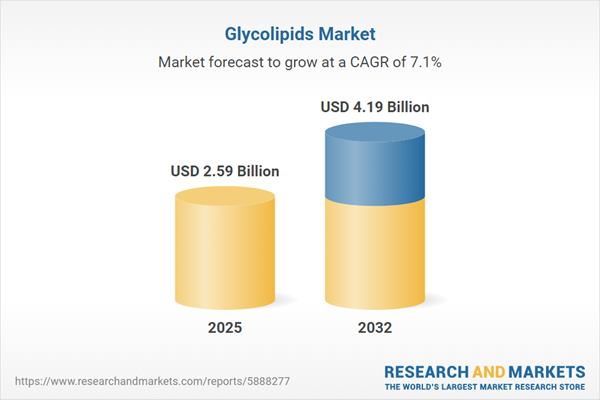Speak directly to the analyst to clarify any post sales queries you may have.
Senior executives confronting complex regulatory and technological changes in the global glycolipids market need actionable insights to guide strategic decision-making. This report consolidates market-defining trends and critical opportunities, equipping organizations to navigate the evolving business environment with clarity.
Market Snapshot: Global Glycolipids Market Size and Trends
The global glycolipids market is valued at USD 2.42 billion in 2024 and is expected to reach USD 2.59 billion by 2025, with a compound annual growth rate (CAGR) of 7.12% forecasted through 2032. Demand for sustainable, high-performance bio-based surfactants is increasing, especially in the personal care, agriculture, and specialty chemical sectors. Growth is fueled by rigorous sustainability mandates, advancements in bioprocessing, and greater transparency requirements, prompting innovation and adaptation across product portfolios. Industry leaders are focusing on technology integration, agile operations, and region-specific strategies to address shifting buyer preferences and regulatory landscapes.
Scope & Segmentation of the Glycolipids Market
- Product Types: Cellobiose lipids, mannosylerythritol lipids, rhamnolipids, and sophorolipids provide diverse biosurfactant solutions. These variants help suppliers address both mainstream and bespoke requirements, aligning functionality with varied application needs in industries such as food, agriculture, and pharmaceuticals.
- Applications: Glycolipids are strategically utilized in agrochemicals, cleaning agents, personal care, oilfield operations, pharmaceuticals, and food and beverage manufacturing. Their adoption accelerates product innovation, ensures compliance, and fosters the development of sustainable formulations.
- Sourcing Routes: Microbial fermentation and synthetic pathways using yeast, bacteria, or enzymatic systems provide robust and responsive supply frameworks. These sourcing models increase scalability and adaptability, helping manufacturers manage ongoing shifts in both market demand and compliance standards.
- Formulations: Glycolipid formats include gels, liquids, powders, raw extracts, and intermediates. This array supports versatile integration into laboratory and industrial environments, enabling buyers to meet demanding technical and quality requirements.
- Sales Channels: Distribution strategies leverage wholesalers, direct enterprise sales, e-commerce, and retail, broadening market reach and strengthening suppliers’ abilities to address diverse client segments and regional market nuances.
- Regional Coverage: The Americas, Europe, Middle East & Africa, and Asia-Pacific markets each contend with specific operational and regulatory challenges, reinforcing the importance of tailored market-entry strategies and robust local alliances.
Key Takeaways for Senior Decision-Makers
- Emerging technologies in microbial and enzymatic processes allow for more differentiated glycolipid products, supporting innovation and operational improvements across key industries.
- Sustainable procurement and flexible supply systems are increasingly emphasized as companies prioritize renewable sources and resilient operations to strengthen future market positioning.
- Organizations are adopting diversified production models to enhance supply chain stability, which is essential for mitigating risks during periods of disruption or unpredictable demand shifts.
- Ongoing investment in infrastructure and R&D drives sector growth, ensuring leaders maintain a competitive advantage in compliance and sustainability.
- Businesses are leveraging cross-industry partnerships and digital transformation initiatives, enabling scalability and responsiveness as they expand into established and emerging regions.
Tariff Impact and Trade Realignment
Recent U.S. tariff actions have complicated international glycolipid supply networks, intensifying market volatility and influencing global stakeholders. In response, domestic manufacturers are strengthening local production capabilities and developing specialized product offerings to stay competitive, while international suppliers focus on regional partnerships and site investments. Proactive risk management has become pivotal for maintaining business continuity and adjusting to evolving trade regulations.
Methodology & Data Sources
This research leverages comprehensive secondary analysis, direct expert consultations, and correlation with up-to-date regulatory frameworks shaping the glycolipids sector. The methodology ensures the insights reflect current market dynamics, supporting informed executive decision-making based on real-time industry drivers.
Why This Report Matters
- Equips executives with clarity on technological growth, regulatory changes, and shifting market trends that inform strategic planning and resource allocation.
- Provides clear segmentation and qualitative analysis, aiding risk assessment, targeted expansion, and market entry strategies across established and growth regions.
- Supplies targeted market intelligence to optimize application and regional decisions, supporting agile leadership in a dynamic competitive landscape.
Conclusion
This comprehensive analysis empowers organizations to adapt effectively, maintain resilience, and seize new opportunities within the evolving glycolipids market environment.
Additional Product Information:
- Purchase of this report includes 1 year online access with quarterly updates.
- This report can be updated on request. Please contact our Customer Experience team using the Ask a Question widget on our website.
Table of Contents
3. Executive Summary
4. Market Overview
7. Cumulative Impact of Artificial Intelligence 2025
Companies Mentioned
The companies profiled in this Glycolipids market report include:- Evonik Industries AG
- Jeneil Biotech, Inc.
- Kaneka Corporation
- SEPPIC SA
- Saraya Co., Ltd.
- Sunson Industry Group Co., Ltd.
- Henan Kexin Biotechnology Co., Ltd.
- Shanghai Sophim Biotech Co., Ltd.
- BASF SE
- Corbion N.V.
Table Information
| Report Attribute | Details |
|---|---|
| No. of Pages | 189 |
| Published | November 2025 |
| Forecast Period | 2025 - 2032 |
| Estimated Market Value ( USD | $ 2.59 Billion |
| Forecasted Market Value ( USD | $ 4.19 Billion |
| Compound Annual Growth Rate | 7.1% |
| Regions Covered | Global |
| No. of Companies Mentioned | 11 |









